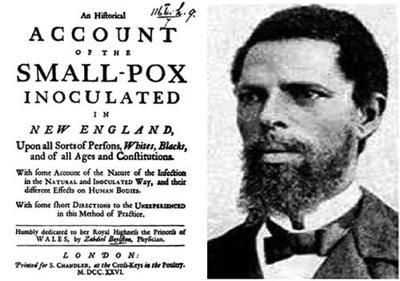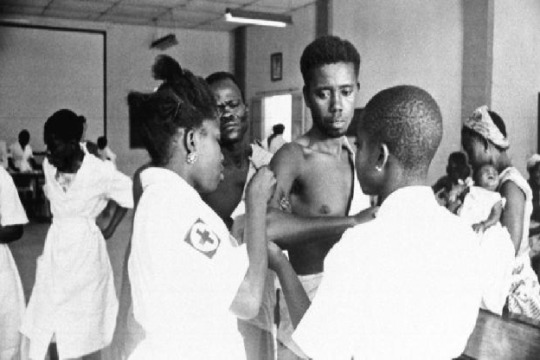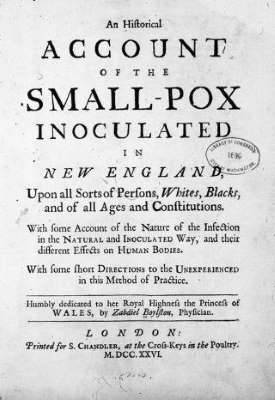Don't wanna be here? Send us removal request.
Text
42 notes
·
View notes
Text
16 notes
·
View notes
Photo

An African slave taught America to vaccinate from smallpox
In April 1721, a smallpox outbreak swept through Boston. This was the latest in a string of six epidemics that had, since, 1630, laid waste to the city. Cotton Mather, a local slave owner and preacher, claimed to be in possession of a way of preventing contraction of the disease. Mather, who had first come to public prominence as one of the thinkers behind the Salem Witch Trials, had gotten the method from one of his former slaves.

Fifteen years earlier, Mather’s congregation had purchased for him an African slave, a “Young Man, who is a Ne***, of a promising aspect and temper.” Mather named him Onesimus, after a slave in the Bible whose name meant “useful.” Mather described Onesimus as being Guramantese, but it is unclear what ethnic group exactly this refers to. One account suggests them to be the Garamante, who correspond to the Berber peoples of southern Libya. Another places Onesimus among the Coromantee from the coastal areas of modern-day Ghana.
Since smallpox was a common scourge in the 18th century, a slave’s value was predicated on his ability to stave off infection. One of the features of smallpox is that a person can only contract it once. Mather asked Onesimus if he had ever suffered from the disease. Mather describes the conversation that followed:

“Enquiring of my Ne*** man, Onesimus, who is a pretty intelligent fellow, whether he had ever had the smallpox, he answered, both yes and no; and then told me that he had undergone an operation, which had given him something of the smallpox and would forever preserve him from it; adding that it was often used among the Guramantese and whoever had the courage to use it was forever free of the fear of contagion.”
The operation Onesimus described was a common procedure in certain parts of the world. What happened was that pus from an infected person was rubbed into an open wound of a person uninfected with smallpox. If one survived this procedure, one was thus inoculated against smallpox, and could never contract it. The procedure was done in different places. In Africa, in China, in India, in the Ottoman empire. Most accounts place the origin of inoculation in either China (where they would blow scabs up a person’s nose) or India, and in both places, it was largely a secret procedure whose technique was passed down mostly in families.
By 1721, inoculation was not entirely unknown in the Western world. It was practiced in Wales and Scotland, and slave traders were known to look for inoculation scars on their slaves. The prices of slaves with the scars would then be hiked up. However, in colonial Boston, as smallpox decimated the population, very few of the inhabitants knew about the procedure. In haste, Mather wrote to the city’s physicians, urging them to perform the procedure so as to save lives.
The resistance was immense. Local newspapers vilified him. A grenade was thrown into his house, the throwers angered that he had dared to inoculate his own son, who almost died. His fellow ministers decried his sin, declaring that it was against God’s will to expose his creatures to dangerous diseases. All the physicians in the town, except one, Zabdiel Boylston, refused to carry out the procedure. The moment Boylston announced his intention to do so, Bostonians took to the streets in protest. Cue the first manifestations of the American anti-vaxxer movement.

The first people Boylston inoculated were his son, and two of his slaves. He was promptly thrown in jail, accused of recklessly trying to spread disease
At the core of Boston’s resistance to inoculation was a heavy racial bias. Mather had made no secret of the fact that he learnt of the procedure from his former slave, and this was the stick the town used against him. Inoculation existed in scientific documents where it was described as a “heathen practice” from Africa. The white puritans of Boston refused to defile their bodies with African heathenisms. To do so would be against God’s will, against predestination. Let God’s will be done. If the Lord God Almighty had decided that it was your day, that was it. Amen. As Peter Manseau notes, “This was not just a health crisis; it was also a theological one. The majority of Puritan clergy regarded the epidemic as divine will.”
The bias made the impact of the smallpox more severe than it should have been. In the end, Boylston was able to inoculate only 248 of the city’s 11,000 residents. Of these 248, only six died, a rate of one in 40. For the rest of Boston, the mortality rate was one in seven, with 844 people dead by the end of the epidemic.

874 notes
·
View notes
Video
7K notes
·
View notes
Text







Malika El Maslouhi By Cedric Bihr For Vogue Ukraine September 2020
3K notes
·
View notes
Video
This 3 minute clip of James Baldwin from a documentary aired on television in early 1969 explaining why “black people are in the streets” remains frustratingly relevant. As Baldwin explains, what was happening then had to do with “the lives they are forced to lead in this country. And they’re forced to lead these lives by the indifference, and the apathy, and a certain kind of ignorance, a very willful ignorance, on the part of their co-citizens.” This was recorded in 1968. It’s been 52 years. History is repeating itself because white America has continued to remain “willfully ignorant.” As Baldwin rightly stated, “we will either live here together or we will die here together. I am telling you, time is telling you, you will either listen or you will perish.”
7K notes
·
View notes
Text
Sign up using my invite link and we’ll both receive NGN 250 worth of Bitcoin when you deposit money into your Luno wallet and buy or sell Bitcoin to the value of NGN 5,000 (Luno exchange not included): https://www.luno.com/invite/RNVPJ
1 note
·
View note
Photo










“Hannibal Barca The African General”
In 247 B.C., the year Hannibal Barca was born, the Carthage empire was about 500 years old. Known as one of the greatest strategist in military history, the battles of Hannibal would strike a turning point in the history of the continent that would be called Africa.
Carthage had been settled by Phoenicians as a city-state in North Africa near the current Tunis. In his 1961 work, French Historian Gabriel Audisio comments that he considered “Hannibal to be neither a Phoenician, nor a Carthaginian, nor a Punic, but a North African… The majority of the Punic populace seems to have had African, indeed Negroid, ancestry.” Whether described as Carthaginians, Phoenicians, or Punics of North Africa, according to Audisio’s research they were certainly a mix of aboriginal North Africans that included the native Berbers, Moors and other groups.
The Phoenicians were a Semitic language people. English writers and speakers can thank the Phoenicians for the current English phonic system. The English Alphabets were borrowed from the Phoenician script. Their cultural influence was wide throughout the Mediterranean Sea nations. They were known as skilled sea merchant traders. They ruled in pre-Roman and pre-historic Iberia (currently Spain and Portugal nations on the Iberian Peninsula), until losing against Rome in the Third Punic War. The city of Carthage was destroyed by the Romans in 146 BC.
There is no picture of Hannibal in existence today. The coin above is frequently presented by commentators as a representation of Hannibal and his legacy of tamed elephants. While this writer was not able to find an academic source for this coin to confirm its date – which was more than 2,000 years ago. The existence of such coinage during some point during our common age is no surprise in light of Hannibal’s historical legacy.
What we do have are descriptions of Hannibal by commentators of his time. According to the Roman historian Levy of the first century of our era, Hannibal was “fearless, utterly prudent in danger, indefatigable, able to endure heat and cold, controlled in eating habits, unpretentious in dress, willing to sleep wrapped in military cloak, a superb rider and horseman.” He was the son of the Carthage general Hamilcar Barca. There is no knowledge of his mother in the history records, not even her name. He had two brothers: Hasdrubal resided in Spain and Maharbal was captain of Hannibal’s calvary.
Carthage and Rome were at war during the First Punic War (264-241 B.C.). Both empires were seeking supremacy over the Mediterranean. Hannibal’s father, Hamilcar Barca, general of the Carthaginian mercenaries, was infuriated about the western Mediterranean losses of Sicily and Sardinia. When Hannibal was 17 years old, however, his father was killed in an ambush in Spain, which was primarily under the rule of the North African empire. Hannibal would son step fully into his military career.In October 218 B.C., during the Second Punic War, Hannibal had arrived at the Alps. His soldiers are said to have stretched for more than eight miles at the Alps, the foothills of the Roman Empire. Hannibal’s army of 100,000 men would trek and fight 1,500 miles to arrive at the Alps from Spain. Hannibal armies included Numidians, North Africans from an area roughly where Algeria now draws its boundaries. The Numidians were known as master horsemen who could guide their horses with their knees, leaving their hands free to use swords and throw javelins.They had fought attacks from European tribes like the Gauls.Hannibal is said to have given this speech to the army of men who had survived and crossed the swift-flowing Rhone river: “Why are you afraid?… The greater part of our journey is accomplished. We have surmounted the Pyrenees; we have crossed the Rhone, that mighty river, in spite of the opposition of thousands of Gauls and the fury of the river itself. Now we have the Alps in sight. On the other side of those mountains lies Italy…. Does anyone imagine the Alps to be anything but what they are–lofty mountains. No part of the earth reaches the sky, or is insurmountable to mankind. The Alps produce and support living things. If they are passable by a few men, they are passable to armies.”
Hannibal lost half of his army in the first two weeks into the Alps. Landslides were touched off by mountain tribes. Men died during hand battle with tribesmen. Starvation and disease were also companions of the embattled lot. Polybus, a Greek historian and contemporary to Hannibal, described Hannibal’s arrival to the Po Valley with about 26,000 men. At the Po Valley, Hannibal is said to have made this speech:“Soldiers! You have now surmounted not only the ramparts of Italy, but also Rome. You are entering friendly country inhabited by people who hate the Romans as much as we do. The rest of the journey will be smooth and downhill, and, after one, or at most a second battle, you will have the citadel and capital of Italy in your possession.“Commentators have speculated on why Hannibal spoke these words because the men were about to face the most difficult part of the journey. Friends did not await in the Po Valley. Here, the Roman army would meet the men in battle. In retrospect, considering how far the men had come, there really was no going back at this point. The Carthaginians believed that Rome was considering an invasion of Africa. Hannibal believed he had to act through an overland attack on Roman to save Carthage. He would spend 15 years in Italy, winning many battles – such as the Battle of Cannae where he lost 6,000 troops to Rome’s 70,000 troops.We know Hannibal did not succeed, but are astonished by how close he came to success. The second of the Punic Wars was over. When Hannibal eventually retreated with his army to Carthage, his army was defeated by Publius Cornelius Scipio in the Battle of Zama. Always sought by the Romans, when Hannibal was about the age of 64 and to be taken prisoner, he took poison and is recorded to have stated:“Let us now put an end to the great anxiety of the Romans who have thought it too lengthy and too heavy a task to wait for the death of a hated old man.”
Once Publics Cornelius Scipio defeated Hannibal, he asked the Africans,they called Berbers, what do you call this place. The Amazigh and other ethnic groups said Ifriqiya, which means sunny place from the Tamazight language. The Scipio became the Africanus,the guy who conquered Africa. Africa is a native name, also Massey, in 1881, stated that Africa is derived from the Egyptian af-rui-ka, meaning “to turn toward the opening of the Ka.” The Ka is the energetic double of every person and the “opening of the Ka” refers to a womb or birthplace. Africa would be, for the Egyptians, “the birthplace.” The later Muslim kingdom of Ifriqiya, modern-day Tunisia, also preserved a form of the name.
http://petitions.moveon.org/sign/banning-exonyms
1K notes
·
View notes
Photo







Scientific racism is the use of scientific techniques and hypotheses to support or justify the belief in racism, racial inferiority, or racial superiority, or alternatively the practice of classifying individuals of different phenotypes into discrete races
1. These tactics still apply today.
2. Anytime any peoples or entities are allowed to develop or false label you it’s a form of scientific racisim
3. If titles you bear don’t come from your language and people it’s a form of scientific racism.
4. Anthropology and all these disciplines were designed for Europeans to discover where the came from.
5. Native Americans never dug up graves and was measuring peoples noses and skulls.
6. In the United States, scientific racism justified African slavery to assuage moral opposition to the Atlantic slave trade. Alexander Thomas and Samuell Sillen described African men as uniquely fitted for bondage, because of their “primitive psychological organization”.
7. Cartwright also described dysaesthesia aethiopica, called “rascality” by overseers. The 1840 United States Census claimed that Northern, free blacks suffered mental illness at higher rates than did their Southern, enslaved counterparts.
8. Scientific racism played a role in establishing Apartheid in South Africa. In South Africa, white scientists, like Dudly Kidd, who published The essential Kafir in 1904, sought to “understand the African mind
9. Rather than suggesting that Africans were “overgrown children,” as early white explorers had, Kidd believed that Africans were “misgrown with a vengeance.” He described Africans as at once “hopelessly deficient,” yet “very shrewd.
10. Nazi Germany’s racially-based social policies placed the improvement of the Aryan race through eugenics at the center of Nazis ideology. Those humans were targeted who were identified as ”life unworthy of life“ (German: Lebensunwertes Leben), including but not limited to Jewish people, criminals, degenerate, dissident, feeble-minded, homosexual, idle, insane, and the weak, for elimination from the chain of heredity. Despite their still being regarded as “Aryan”, Nazi ideology deemed Slavs (i.e., Poles, Russians, Ukrainians, etc.) to be inferior to the Germanic master race, suitable for expulsion, enslavement, or even extermination
11. In the US, eugenicists such as Harry H. Laughlin, and Madison Grant sought to “scientifically” prove the physical and mental inadequacy of certain ethnic groups to justify compulsory sterilization and restrict immigration, per the Immigration Act of 1924; compulsory sterilization continued until the 1960s and later.
12. Lothrop Stoddard published many racialist books on what he saw as the peril of immigration, his most famous being The Rising Tide of Color Against White World-Supremacy in 1920. In this book he presented a view of the world situation pertaining to race focusing concern on the coming population explosion among the “colored” peoples of the world and the way in which “white world-supremacy” was being lessened in the wake of World War I and the collapse of colonialism.
13. Franz Ignaz Pruner (1808–1882) was a medical doctor who studied the racial structure of Negroes in Egypt. In a book which he wrote in 1846 he claimed that Negro blood had a negative influence on the Egyptian moral character
14. Arthur Schopenhauer (1788–1860), The highest civilization and culture, apart from the ancient Hindus and Egyptians, are found exclusively among the white races; and even with many dark peoples, the ruling caste, or race, is fairer in colour than the rest, and has, therefore, evidently immigrated, for example, the Brahmins, the Inca, and the rulers of the South Sea Islands.
15. Likewise, Montesquieu’s theory of the influence of climate on cultural mores and law “scientifically” justified the idea of Negro inferiority.Hegel declared that “Africa is no historical part of the world.” Hegel further claimed that blacks had no “sense of personality; their spirit sleeps, remains sunk in itself, makes no advance, and thus parallels the compact, undifferentiated mass of the African continent.
16. Friedrich Tiedemann, was one of the first to make a scientific contestation of racism. He argued based on craniometric and brain measurements taken by him from Europeans and black people from different parts of the world that the then-common European belief that Negroes have smaller brains, and are thus intellectually inferior, is scientifically unfounded and based merely on the prejudice of travellers and explorers
17. Georges Cuvier (1769–1832), the French naturalist and zoologist, influenced scientific polygenism and scientific racism. Cuvier believed there were three distinct races: the Caucasian (white), Mongolian (yellow) and the Ethiopian (black). He rated each for the beauty or ugliness of the skull and quality of their civilizations. Cuvier wrote about Caucasians: "The white race, with oval face, straight hair and nose, to which the civilised people of Europe belong and which appear to us the most beautiful of all, is also superior to others by its genius, courage and activity.
18. In Meiners’s large work entitled Researches on the Variations in Human Nature (1815), he studied also the sexology of each race. He claimed that the African Negroids have unduly strong and perverted sex drives, whilst only the White Europeans have it just right
19. Meiners split mankind into two divisions, which he labelled the "beautiful White race” and the “ugly Black race”. In Meiners’s book The Outline of History of Mankind, he said that a main characteristic of race is either beauty or ugliness. He thought only the White race to be beautiful. He considered ugly races to be inferior, immoral and animal-like. He said that the dark, ugly peoples were distinct from the white, beautiful peoples by their “sad” lack of virtue and their “terrible vices”
20. We were scientifically produced by the white man. Whenever you see somebody who calls himself a Negro, he’s a product of Western civilization–not only Western civilization, but Western crime. The Negro, as he is called or calls himself in the West, is the best evidence that can be used against Western civilization today.- MALCOLM X
21. Negro doesn’t tell you anything. I mean nothing, absolutely nothing. What do you identify it with? Tell me. Nothing. What do you attach it to, what do you attach to it? Nothing. It’s completely in the middle of nowhere. And when you call yourself that, that’s where you are–right in the middle of nowhere. It doesn’t give you a language, because there is no such thing as a Negro language. It doesn’t give you a country, because there is no such thing as a Negro country. It doesn’t give you a culture–there is no such thing as a Negro culture, it doesn’t exist. The land doesn’t exist, the culture doesn’t exist, the language doesn’t exist, and the man doesn’t exist. They take you out of existence by calling you a Negro. And you can walk around in front of them all day long and they act like they don’t even see you. Because you made yourself nonexistent. It’s a person who has no history; and by having no history, he has no culture- MALCOLM X
22. Hispanic(Spain), Latino(Italy), China(Zhugguo), India(Bharat), Black(Nothing), Yellow(Nothing),Negro(Nothing),Nigger(Nothing),Colored(Nothing)
23. There are no technical aspects of nature. There is no text book definition of an Afrakan,European or Asian. Trying to make theses entites technical will give birth to scientific racism.
24. Caucasians are not a race it’s an ethnic groups in Russia. Mongols are an ethnic group in Zhugguo.
25. In the 19th century, European authors classified the Hamitic race as a sub-group of the Caucasian race, along with the Semitic race – thus grouping the non-Semitic populations native to North Africa and the Horn of Africa, including the Ancient Egyptians. According to the Hamitic theory, this “Hamitic race” was superior to or more advanced than Negroid populations of Sub-Saharan Africa. In its most extreme form, in the writings of C. G. Seligman, this theory asserted that virtually all significant achievements in African history were the work of “Hamites” who migrated into central Africa as pastoralists, bringing new customs, languages, technologies and administrative skills with them. In the early 20th century, theoretical models of Hamitic languages and of Hamitic races were intertwined.
26. Scientific racism played a key role in Rwanda, European measures skulls and noses between the Tutsi, and Hutus. Europeans favored Tutsi, deeming them more Caucasian like. “Only in Rwanda and Burundi did the Hamitic hypothesis become the basis of a series of institutional changes that fixed the Tutsi as a race in their relationship to the colonial state
27. In the United States, having a European ancestry, or perceived to have European features, deems an African a more social status.
Ban exonyms from School,Government and Public documents
https://www.youtube.com/watch?v=Hu0z6zyc2J8
2K notes
·
View notes
Video
tumblr
When you come to a country you should speak the language!!!!!!!
When your in America you should change your name to a European name!
Hmm! Do Europeans in Africa change their names to African names? Do Europeans speak the language?!
Are Europeans trying to make African ppl great.
Respect the laws of the country but you don’t respect African ppl!!???
And African ppl allow this shit to happen they should kill all of them!
815 notes
·
View notes


